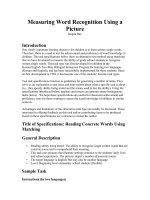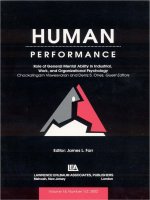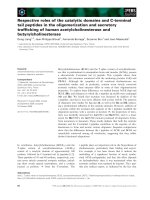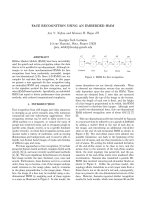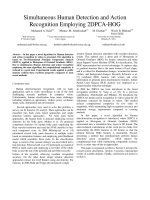highly efficient human action recognition using compact 2dpca-based descriptors in the spatial and transform domains
Bạn đang xem bản rút gọn của tài liệu. Xem và tải ngay bản đầy đủ của tài liệu tại đây (354.33 KB, 4 trang )
Simultaneous Human Detection and Action
Recognition Employing 2DPCA-HOG
Mohamed A. Naiel
(1)
Moataz M. Abdelwahab
(1)
M. Elsaban
(2)
Wasfy B. Mikhael
(3)
Fellow IEEE
(1)
Nile University
(2)
Cairo Microsoft Innovation Lab
6
th
October, Egypt Cairo, Egypt
(3)
University of Central Florida
Orlando, FL, USA
, ,
Abstract— In this paper a novel algorithm for Human detection
and action recognition in videos is presented. The algorithm is
based on Two-Dimensional Principal Components Analysis
(2DPCA) applied to Histogram of Oriented Gradients (HOG).
Due to simultaneous Human detection and action recognition
employing the same algorithm, the computational complexity is
reduced to a great deal. Experimental results applied to public
datasets confirm these excellent properties compared to most
recent methods.
I. INTRODUCTION
Human detection/action recognition, with its many
applications such as video surveillance is one of the most
challenging research problems in computer vision.
Unfortunately, human classification faces many challenges
including variation in appearance, clothes, poses, occlusion,
shape, scale, illumination and environment.
Several approaches were used to solve this problem, a
survey can be found in [1], and [2]. These approaches can be
classified into body parts based approaches and single
detection window approaches. For body parts based
approaches, the human body is detected employing several
detectors for the body parts. Mohan et al. [3] proposed
component detectors for human body parts employing the
Haar wavelet transform and used the SVM classifier to fuse
each component score. In 2004 Mikolajczyk et al. [4]
introduced several body parts detectors at multiple scales
based on orientation features, and employing joint likelihood
model which assembles these parts. In the classification
stage, a coarse-to-fine cascade strategy was used which led to
fast detection. Felzenszwalb et al. [5] performed a pyramid of
HOG at multi-scales and employing a root filter of the whole
body at near the top of the pyramid and part filters near the
bottom of the pyramid, achieving excellent recognition
accuracy. On the other hand, single window detection
approaches extract low level features using one detector. For
instance, In 2006 Dalal and Triggs [6] introduced a single
window human detection algorithm with excellent detection
results. This method uses a dense grid of Histograms of
Oriented Gradients (HOG) for feature extraction and using
linear Support Vector Machine (SVM) for classification. The
HOG representation has several advantages. It captures edge
or gradient structure that is the main feature of local shape,
and it is robust for illumination changes, invariant for human
clothes, and background changes. Recently Schwartz et al.
[7] combined HOG features with texture and color
information to generate more discriminative features, further
Partial Least Squares (PLS) analysis was employed as a
dimensionality reduction technique.
In 2004 the 2DPCA has been introduced to the facial
recognition problem by Yang et al. [8]. In a previous
contribution. Abdelwahab and Mikhael. [9] introduced the
2DPCA for human action recognition in videos using the 2D
silhouettes extracted for humans in videos. This method
reduces computational complexity by two order of
magnitude, while maintaining high recognition accuracy and
minimum storage requirements compared to existing
methods.
In this paper, a novel algorithm for Human
detection/action recognition is introduced, where 2DPCA is
applied to Histogram of Oriented Gradients (HOG)
represented into, n orientation bins, layers in 2D format. The
main technical contributions of this work are two folds, first
representing the HOG features in 2D format so that the
relation between HOG features is maximized. Second,
presenting a method that simultaneously perform human
detection/ action recognition which reduces the
computational time while maintaining comparable accuracy
levels, as other state-of-the-art approaches.
This paper is organized as follows. Section 2 presents the
overall system description,. Section 3 presents experimental
results on a public datasets. Finally, conclusions are drawn in
section 4.
II. OVERALL SYSTEM DESCRIPTION
The proposed human detection/action recognition system
consists of a parallel structure (layers) shown in Figure 1. First
HoG B-bin features are extracted for every frame. The
2DPCA is applied on every bin layer independently, and then
feature concatenation is used to fuse the 2DPCA features. The
K-Nearest Neighbor (KNN) Classifier is used to infer the
most likely class for the input view. Finally, this algorithm can
be extended to multi-camera system using a majority voting
technique to arbitrate between independent camera decisions.
In the following subsections description for the HoG features
representation and the proposed algorithm will be presented.
A. The HoG features
The proposed human descriptor is based on applying the
2DPCA on the HOG features, so that multiple instances can
be extracted from the same frame. In our experiments the
recognition system works as follows. Each detection window
of size 128x64 pixels is divided into 15x7 blocks (with one
cell overlap), where every block consists of 2x2 cells and each
cell consists of 8x8 pixels. Each cell is represented by 9
Histogram of Orientation Gradients bins from 0° to 180°.
These bins will be arranged into 9 images (or channels),
where the spatial location is maintained. The output is 9
images each of size 30x14, compared to one feature vector of
size 1x3780 in Dalal-Trigges [6] method (same numbers were
used for comparison)
B. The Proposed Algorithm
Feature extraction is carried in the spatial domain using
2DPCA. The algorithm is divided into two modes, the training
mode and the testing mode. The input patterns are the 2D-
HoG B-bins frames. Let k denote the number of training
frames, the j
th
training frame is denoted by an (m x n) matrix
, and the average image of all training
samples is denoted by
. Let denote the number of training
videos, and denotes the number of frames for the i
th
training
video
, where the size of every frame is
(m x n). Let
and
denote the number of centroids
per video computed in the training and testing modes,
respectively. The training and testing algorithms are in
Algorithms 1 and 2 respectively, where the training algorithm
represents one path from the multi-camera system.
Training Algorithm
Input:
,
,
Output: matrices
and vector
1. for 1 to B step 1 do // for all HoG bins
2. Compute the average for all frames in
;
3. Compute the covariance matrix as
;
4. Compute the r eigenvectors
of
corresponding to the largest r eigenvalues;
5.
;
6. end for
7. for 1 to step 1 do // for all training videos
8. for 1 to step 1 do // for all frames in video
9. for 1 to B step 1 do // for all bins layers
10.
;
11.
Concatenate
;
12. end for
13.
;
14. end for
15. Compute
centroids for i
th
video as
and
;
16. end for
Algorithm 1: Training mode algorithm for every camera/multi-input
Figure 1: The proposed human action recognition system.
Bin (1) layer
2DPCA
(Train or
Test mode)
2DPCA
(Train or
Test mode)
Detection
Compute B -
bins HoG
frames
2DPCA
(Train or
Test mode)
Input video
(Camera)
Action 1
Action 2
Action 3
Action 4
Action (i)
Features
concatenation
f={f
1
, f
2
B
}
f
1
f
2
f
B
Bin (B) layer
Bin (2) layer
Classifier
(K-NN)
Testing Algorithm
Input:
, Ncam,
Output:
1. for 1 to Ncam step 1 do// for every camera
2. for 1 to T step 1 do// for all testing frames
3. for 1 to B step 1 do // for all bins layers
4.
;
5.
;
6. end for
7.
;
8. end for
9. Compute
centroids for the testing video as
10. for 1 to
step 1 do
11.
; // using the
Euclidean distance or any distance rule.
12.
// decision per tested centroid
13.
//minimum distance tested centroid
14. end for
15. if
majority voting then
16.
Action corresponding to majority labels.
17.
//minimum
distance per camera.
18. else
19.
Action corresponding to minimum
20.
//minimum distance per
camera.
21. end if
22. end if
23.
Majority voting technique to infer the
decisions are ignored, if the majority voting is not
satisfied, the system chooses the decision of the
camera with minimum
.
Algorithm 2: Testing mode algorithm for the multi-camera system.
III. EXPERIMENTAL RESULTS AND ANALYSIS
The performance of the proposed algorithm was measured
as follows, (i) For detection , the INIRIA person dataset was
used [10]. (ii) For recognition, the Weizmann Action Dataset
was employed [13]. All the results were obtained using CPU,
3 GHz dual core processor with 4GB of RAM .
3.1. INIRIA dataset
In this dataset persons are standing with different
orientations, and with large variation in background views as
shown in Figure 2. The training dataset consists of 1208
positive (each of size 96x160) and 1222 negative examples,
where the positive examples are left-right reflected to give a
total of 2416 positive examples. The testing dataset consists
of 1126 (each of size 70x134) positive class and 453 negative
class images. A random sample of six detection windows per
image was taken for both training and testing negative
datasets.
Figure 2. Sample images from INIRIA pedestrian dataset [10],
shown examples for positive and negative classes, in the first and
second row respectively.
In the proposed training algorithm the numbers of dominant
eigenvectors (r) were selected for every channel to maintain
95% of the energy of the dominant eigenvalues. For every
channel the system generates 2416 and 7332 feature vectors
for the positive and negative classes respectively. The
average time used for feature extraction from the 9-channels
of the HOG with 2DPCA is 23.5 mins. For fast testing the K-
means was employed to group the positive class into 30
centroids, while group the negative class into 250 centroids.
The average time used for grouping was 15 mins. The
average testing time per detection window (128x64) was 52
msec .
The 2DPCA recognition system was trained on the 2D
Multilayer HOG images, and in the testing phase the multiple
features were fused using voting technique. The AUC for our
approach is 0.9841 while in [6] the AUC is 0.91. Also the
Equal Error Rate (EER) for our system is 0.951 compared
with Dollar et al. [12] 0.954, Maji et al. [11] 0.945.
Figure.3 compares the proposed algorithm performance
with the best performance in previous published reports [11]
and [12]. The average size of the feature vectors is 1x314
compared to 1x3780 for Dalal- Triggs [6]. Thus the feature
space is reduced by 91.7%. Further grouping the features
using K-means reduces the number of comparisons in the
testing mode by a factor of approximately two orders of
magnitude, while maintaining the highest recognition
accuracy. These properties confirm that the proposed
representation for the HOG features has discriminative
properties. In other experiment, the parallel structure features
generated from the 2DPCA were concatenated to give one
feature vector for every input image in both the training and
testing modes. This experiment gives consistent results with
the parallel structure with voting scheme.
Figure 3. ROC Curve comparing the performance of the proposed
algorithm with two recent reports [11] and [12].
3.2. Weizmann dataset
The proposed Algorithm was applied to the Weizmann
Action Dataset [13] for human action recognition.
Experimental results were compared to methods that were
recently published. The Weizmann dataset consists of 90 low-
resolution (180 x 144, 50 fps) video sequences showing nine
different actors, each performing 10 natural actions such as
walk, run, jump forward, gallop sideways, bend, wave one
hand, wave two hands, jump in place, jump-jack, and skip, as
Table I shows that we are maintaining the excellent
recognition accuracy compared with other recently published
approaches. Table II presents our proposed algorithm run
time, which is faster than other available record [10].
Method
Accuracy
Testing technique
HoG-9Bins/SD
94.38%
Leave one-actor out
Silhouette/SD [10]
96.19%
Leave one-video out
Silhouette/TD [10]
96.75%
Leave one-actor out
Ali & Shah [14]
95.75%
Leave one-actor out
Yuan et al. [15]
92.90%
Leave one-actor out
Yang et al. [16]
92.80%
Leave one-actor out
Niebles & Fei-Fei [17]
72.80%
Leave one-actor out
Table 1: Comparison of the average recognition accuracy on the
Weizmann dataset with the best reported accuracy (Italic indicates
our approach).
Average time
in sec
Time standard
deviation
in sec
Time HoG/Frame
T
0.4146
0.0120
Projection and Kmeans Time/Video
0.1295
0.0488
Classification time/Video
0.1190
0.0133
Total time/video
25.1245
0.7821
Table 2: Comparison of the average testing time on the Weizmann
dataset
IV. CONCLUSIONS
A novel algorithm based on Two-Dimensional Principal
Components Analysis applied to Histogram of Oriented
Gradients for Human detection/Classification is presented.
Experimental results applied to public datasets shows that the
computational requirements have been reduced to a great deal
while maintaining excellent recognition accuracy, compared
to recent methods. As far as future work is concerned, using
the proposed technique in the transform domain can lead to
reduced computational and storage requirements.
V. REFERENCES
[1]
Journal of Computer Vision and Image Understanding, vol. 73, pp. 82-
98, (1999).
[2]
vision- , Journal Computer
Vision and Image Understanding vol. 104, no. 2, pp. 90-126,
Nov.2006.
[3] A. Mohan, C. Papageorgiou, and T. Poggio. Example-based object
detection in images by components. IEEE Transactions on PAMI, vol.
23 no. 4, pp.349-361, 2001.
[4]
on a probabilistic assembly of
Conference on Computer Vision 2004, Prague, Czech Republic, pages
6982, May 2004.
[5] P. F. Felzenszwalb, R. B. Girshick, D. McAllester and D. Ramanan
"Object detection with discriminatively trained part based models"
IEEE Tran. on PAMI, vol.32, no.9, pp.1627-1645, Sep. 2010
[6] N. Dalal, and B. Triggs "Histograms of oriented gradients for human
detection" IEEE Computer Vision and Pattern Recognition 2005, San
Diego, CA, USA , pp.886-893 vol. 1, 25-25 Jun.2005.
[7] W. R. Schwartz, A. Kembhavi, D. Harwood, L. S. Davis, "Human
detection using partial least squares analysis," IEEE International
Conference on Computer Vision, Kyoto, Japan, pp.24-31, Sept Oct.
2009.
[8] -dimensional
PCA: A new approach to appearance-based face representation and
-137, Jan.
2004.
[9]
recognition employing 2DPCA and VQ in the spatio-temporal
EE NEWCAS, Montreal, Canada, pp.381-384, Jun. 2010.
[10] last retrieved on Jan. 21, 2011.
[11] S. Maji, A.C. Berg "Max-margin additive classifiers for
detection," IEEE International Conference on Computer Vision, Kyoto,
Japan, pp.40-47, Sep Oct. 2009.
[12] P. Dollar, Zhuowen Tu; Hai Tao, S. Belongie, "Feature mining for
image classification" IEEE Conference on Computer Vision and
Pattern Recognition, Minneapolis, MN, USA, pp.1-8, Jun. 2007.
[13] www.wisdom.weizmann.ac.il/~vision/SpaceTimeActions.html,
[14] Saad Ali, Mubarak Shah, "Human Action Recognition in Videos
Using Kinematic Features and Multiple Instance Learning," IEEE
PAMI, vol. 32, no. 2, pp. 288-303, Feb. 2010.
-537,Sep. 2009.
single
2009.
[17] J. C. Niebles and L. Fei-
Minneapolis, MN, pp. 1-8, June 2007.

